引言
Apache Atlas 是托管于 Apache 旗下的一款元数据管理和治理的产品,目前在大数据领域应用颇为广泛,可以很好的帮助企业管理数据资产,并对这些资产进行分类和治理,为数据分析,数据治理提供高质量的元数据信息。
随着企业业务量的逐渐膨胀,数据日益增多,不同业务线的数据可能在多种类型的数据库中存储,最终汇集到企业的数据仓库中进行整合分析,这个时候如果想要追踪数据来源,理清数据之间的关系将会是一件异常头疼的事情,倘若某个环节出了问题,追溯的成本将是巨大的,于是 Atlas 在这种背景下应运而生了,通过它,我们可以非常方便的管理元数据,并且可以追溯表级别,列级别之间的关系(血缘关系),为企业的数据资产提供强有力的支撑和保障。Atlas 支持从 HBase 、Hive、Sqoop、Storm、Kafka 中提取和管理元数据,同时也可以通过 Rest Api 的方式自行定义元数据模型,生成元数据。
本文我们着重介绍一下 Atlas 的相关概念,帮助大家更好的理解 Atlas,同时详细讲解如何通过 Rest Api 的方式自定义数据模型,生成血缘关系,以便开发自己的个性化需求。
Atlas 原理及相关概念
元数据
元数据其实就是描述数据的数据,比如表,字段,视图等,每个业务系统可能都会自己定义表,字段,视图,这些数据从哪来到往哪去,数据之间是否存在关联,和其他系统的数据是否存在重复和矛盾字段,这些就是元数据管理要解决的问题,也是 Atlas 要解决的问题。
运行原理
Atlas 的原理其实并不难理解,主要是通过内部提供的脚本读取数仓中的数据库结构,生成数据模型,存储到 Atlas的 Hbase 中,同时通过 hook 的方式监听数仓中的数据变化,分析执行的 sql 语句,从而生成表与表,列与列的血缘关系依赖,在前台展示给用户查看。
数仓支持
Atlas 对 Hive 支持最好,我们都知道,Hive 是依赖于 Hadoop 的,数据存储在 HDFS 中,Atlas 有专门的 shell 脚本可以直接运行读取 Hive 的表结构等元数据信息同步到 Atlas 的存储库中,自动生成元数据模型,同时 Atlas 提供的 HiveHook 可以监听 Hive 的数据变化,根据 Hive 执行的 sql 推断出数据与数据之间的关系,生成血缘关系图,如果我们想要分析其他数据存储介质的元数据和血缘关系,Atlas 的支持并不是很理想。但通常情况下,我们会定时把业务库如 mysql,oracle 中的数据定时同步到数仓中整合分析,而数仓我们一般都会采用 Hadoop 的生态体系,所以这一点并不是问题。
架构图解
以下是 Atlas 的架构图解,可以看出,Atlas 所依赖的生态体系是异常庞大的,这也直接导致了它部署起来十分繁琐,本文不再讲解 Atlas 的部署,网上相关的教程有很多,感兴趣的朋友可以自己搜索尝试。
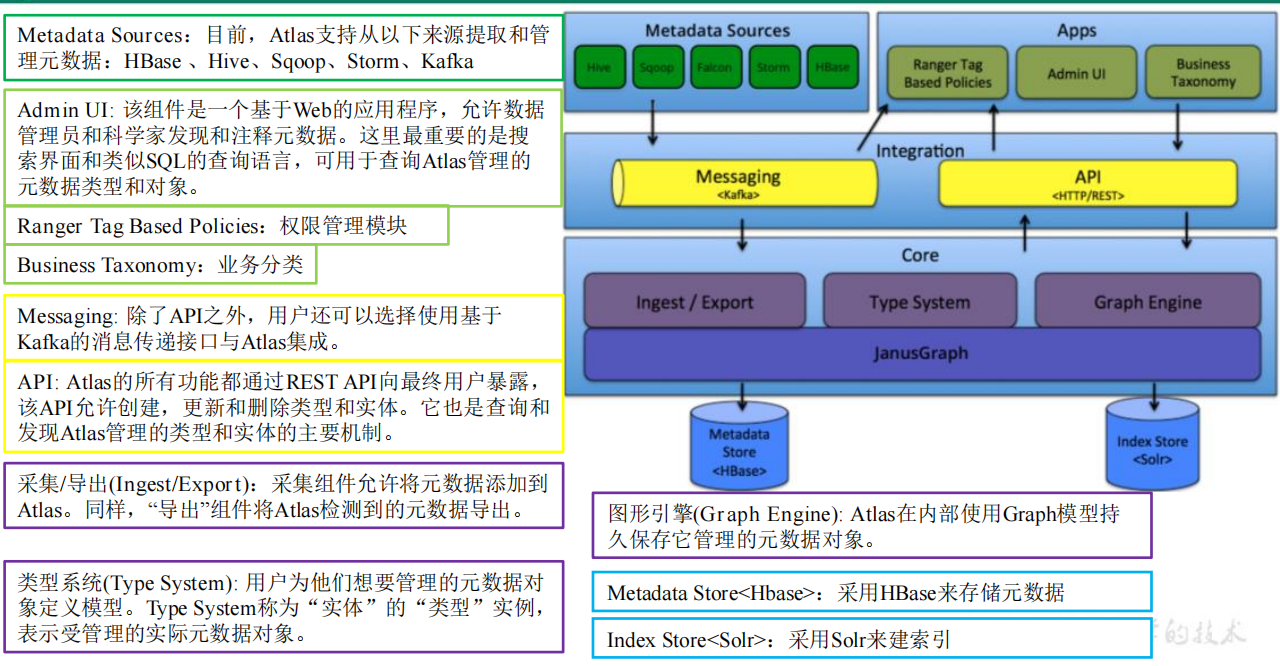
核心组件概念
Atlas 中主要有以下核心组件,这些需要我们着重了解,接下来我们通过 Rest Api 自定义建模其实就是对以下组件的增删查改操作。
1. Type
元数据类型定义,这里可以是数据库,表,列等,还可以细分 mysql 表( mysql_table ),oracle 表( oracle_table )等,atlas自带了很多类型,如 DataSet,Process 等,一般情况下,数据相关的类型在定义类型的时候都会继承 DataSet,而流程相关的类型则会继承 Process,便于生成血缘关系。我们也可以通过调用 api 自定义类型。这是一切的起点,定义完类型之后,才能生成不同类型的元数据实体,生成血缘关系,我个人更喜欢把元数据类型称之为建模。
2. Classification
分类,通俗点就是给元数据打标签,分类是可以传递的,比如 A 视图是基于 A 表生成的,那么如果 A 表打上了 a 这个标签,A 视图也会自动打上 a 标签,这样的好处就是便于数据的追踪。
3. Entity
实体,表示具体的元数据,Atlas 管理的对象就是各种 Type 的 Entity。
4. Lineage
数据血缘,表示数据之间的传递关系,通过 Lineage 我们可以清晰的知道数据的从何而来又流向何处,中间经历了哪些操作,这样一旦数据出现问题,可以迅速追溯,定位是哪个环节出现错误。
Altas 使用
Altas 成功部署之后,使用还是很简单的,这是登录界面,用户名密码默认是 admin,admin:
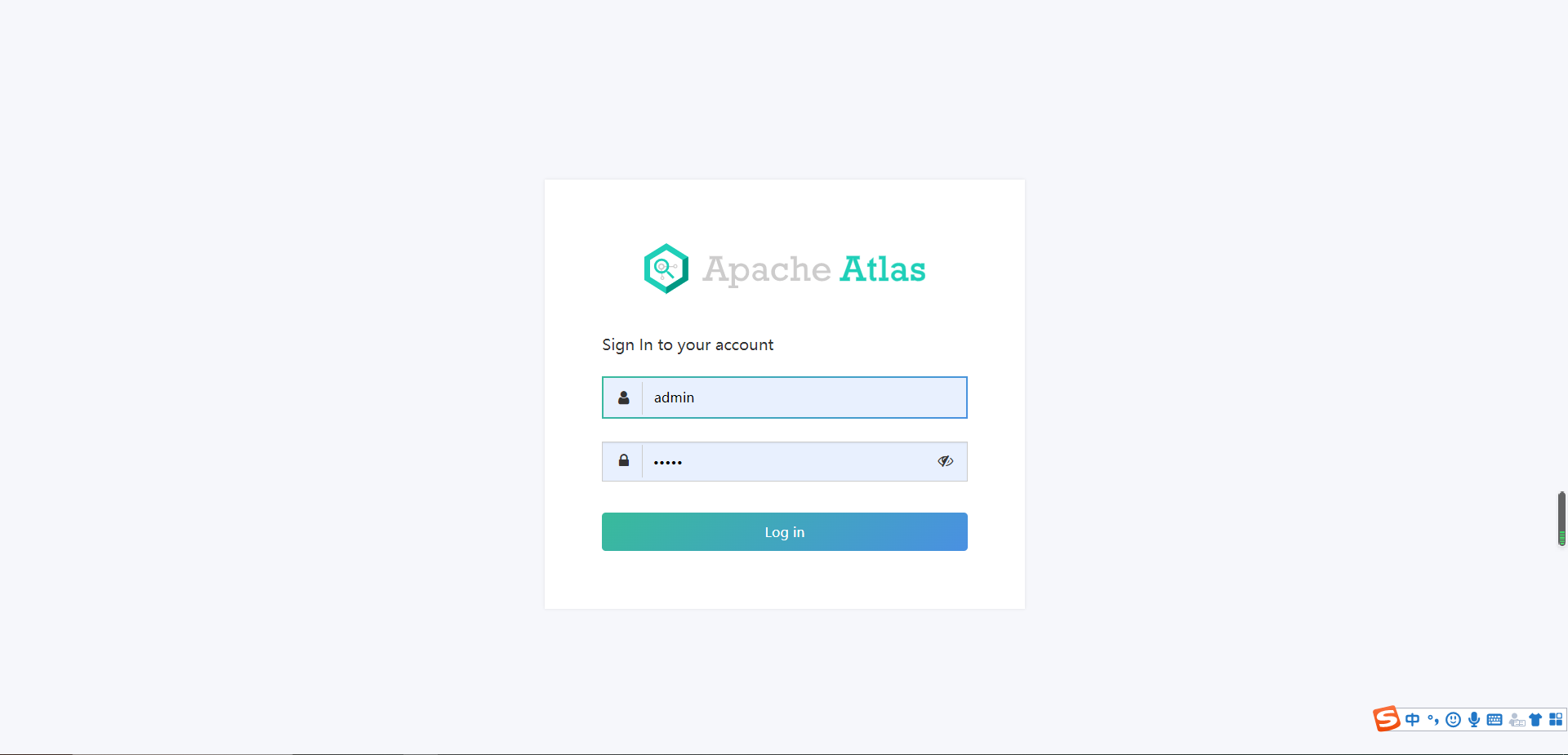
进入主页,点击右上角 switch to new ,使用新版界面,更直观:
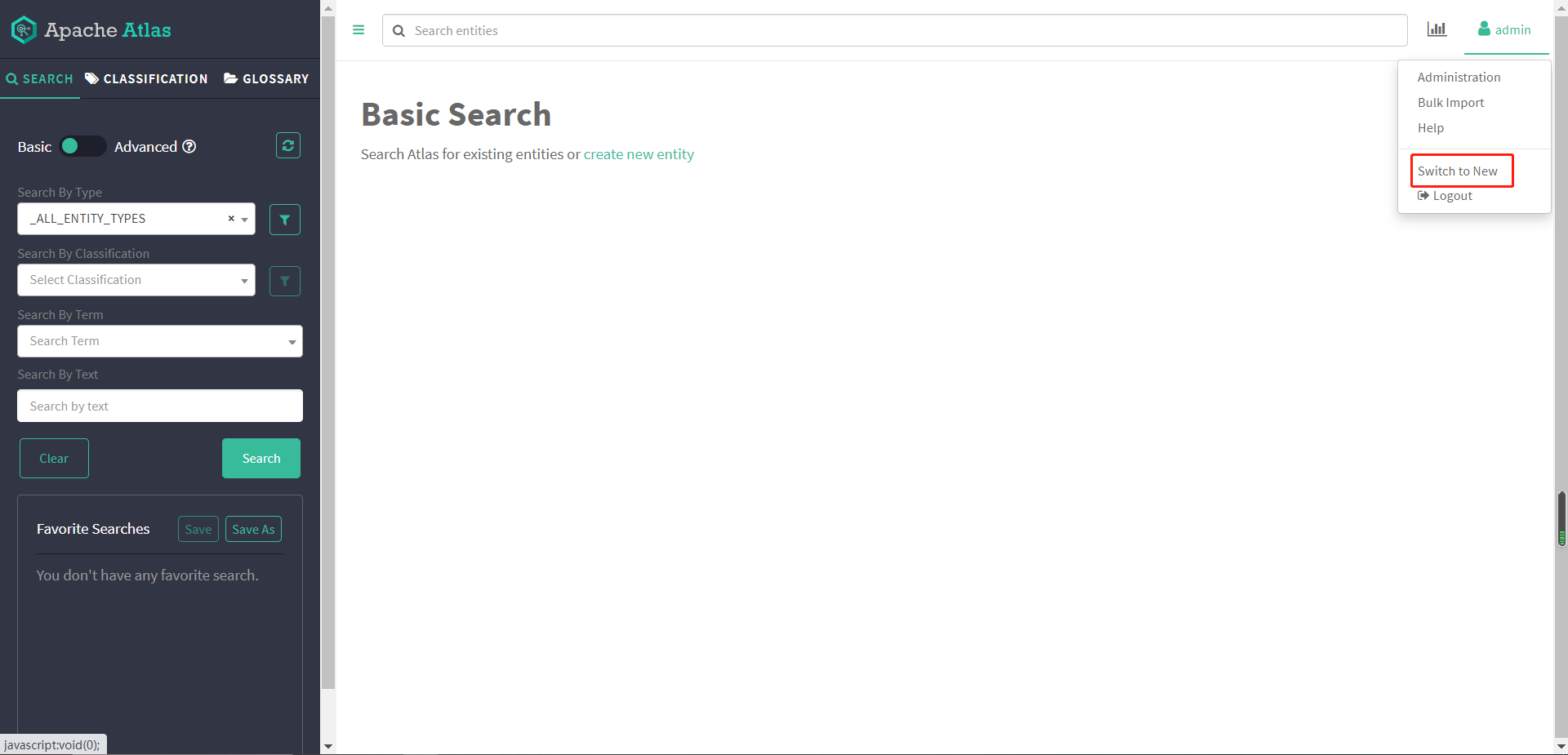
 页面左侧便是 Atlas 的类型树,点击树节点的某个类型,可以查看下面的实体,这里我们点击 mysql_table:
页面左侧便是 Atlas 的类型树,点击树节点的某个类型,可以查看下面的实体,这里我们点击 mysql_table:
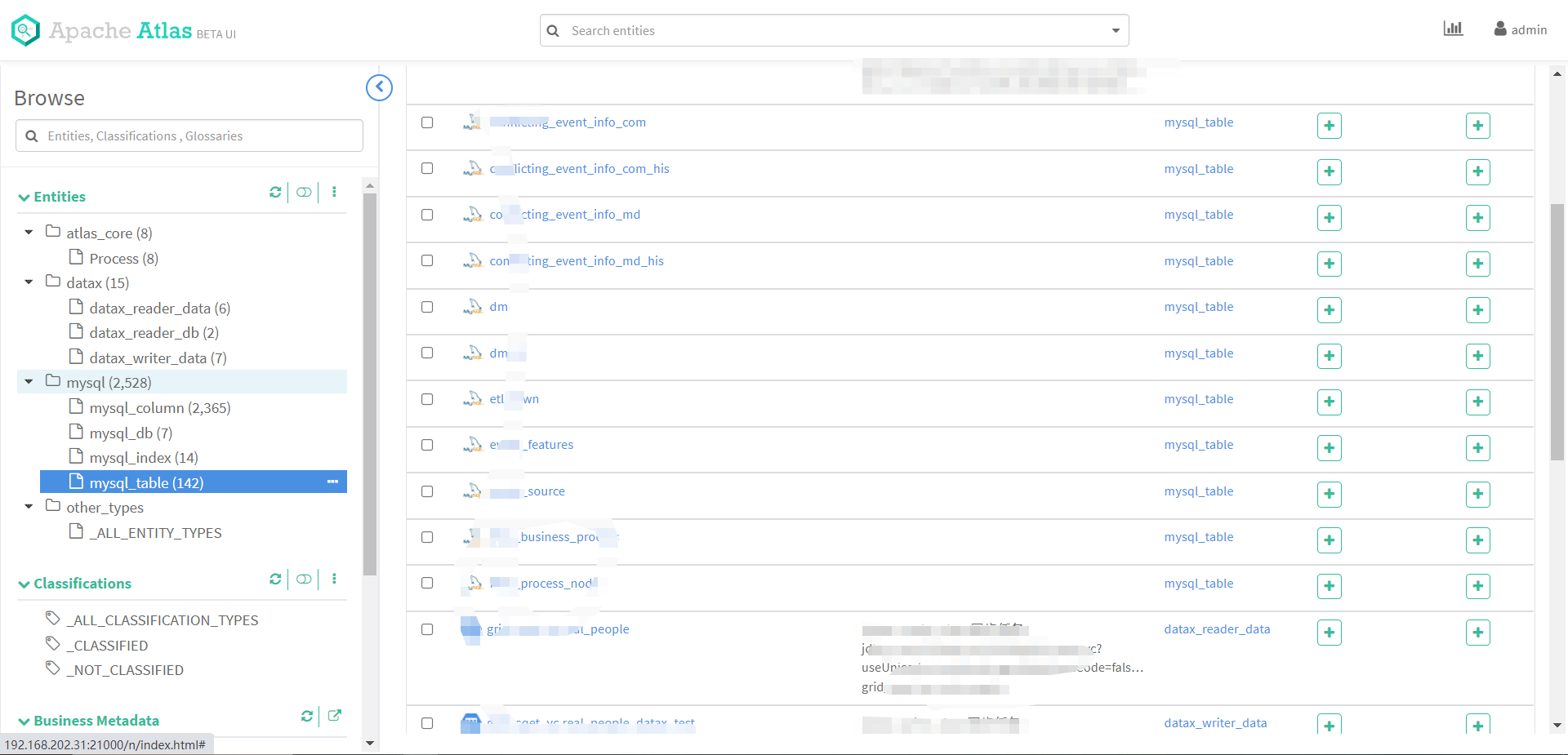
可以看到下面有很多表,这些都是我之前自己利用 Rest Api 上传定义的,下面我们来讲解一下如何通过 Rest Api 的方式自定义类型,生成实体,创建血缘关系。
Atlas Rest Api 详解及示例
我们点击主页上方的 Help-》API Documentation,便可以查看 Atlas 所有的开放接口:
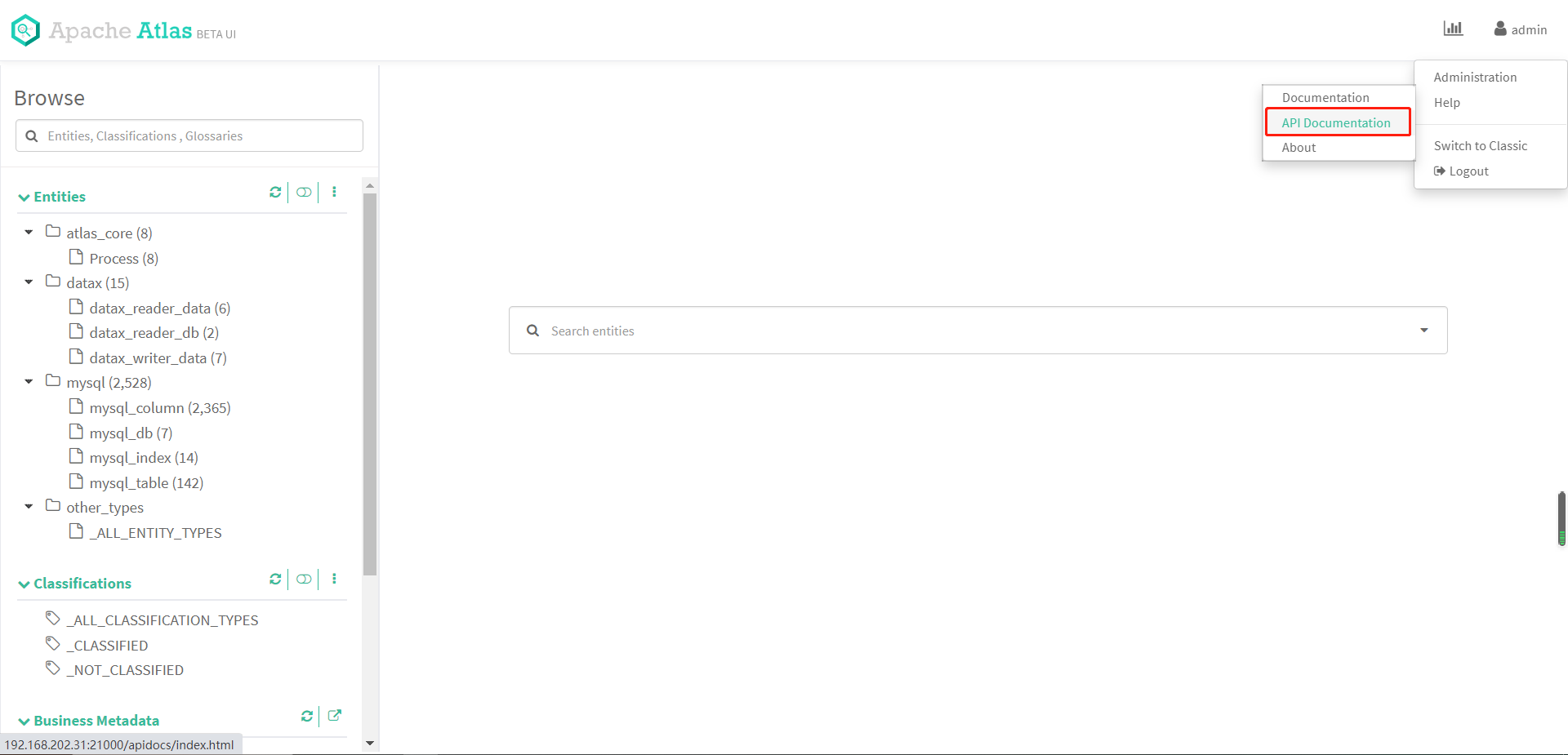
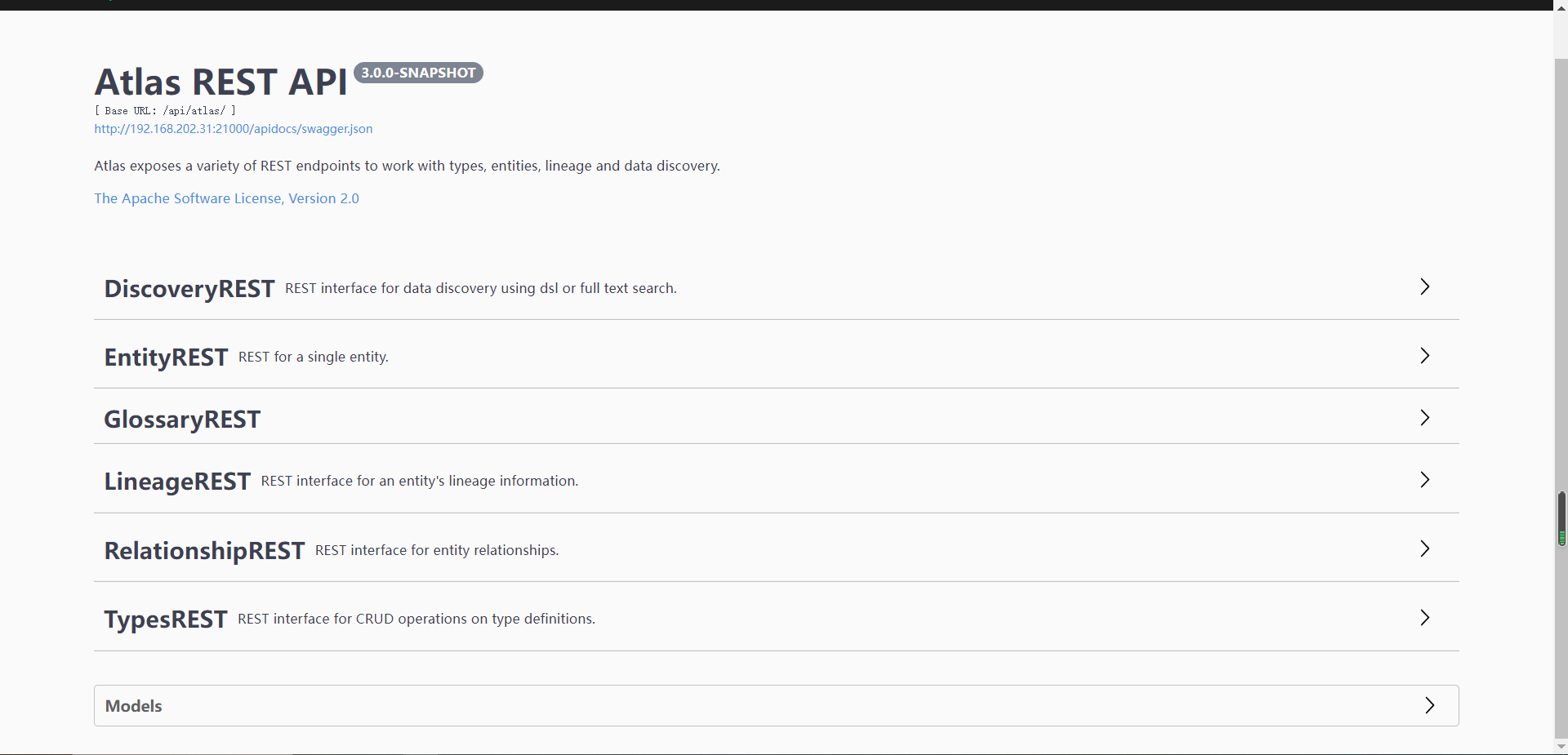
有一点我们需要注意,Atlas 的接口在使用的时候是需要鉴权的,所以我们构建 http 请求的时候需要带上用户名和密码认证信息,本次示例中我们使用 atlas-client-v2 开源组件来进行 Atlas 的 api 调用。
本次示例我们定义一个 my_db 类型,my_table 类型,并且让 my_db 一对多 my_table,然后创建 test_db 实体到 my_db 下,创建 test_table_source 和 test_table_target 实体到 my_table 下,并且定义 test_table_target 的数据来自 test_table_source,生成两个实体的血缘关系依赖。
自定义 my_db 和 my_table 类型
我们对 my_db 和 my_table 类型进行定义,在 Atlas 的Rest Api 中,允许一个请求定义多种类型,在这里我们先构建 json 请求体,然后再通过编码方式实现,二者对比,更容易理解,json 请求体如下(关键地方有注释):
{
"enumDefs": [],
"structDefs": [],
"classificationDefs": [],
//类型定义
"entityDefs": [
{
"name": "my_db",
//数据类型的定义,约定俗成,继承Atlas自带的DataSet
"superTypes": [
"DataSet"
],
//服务类型(便于在界面分组显示类型)
"serviceType": "my_type",
"typeVersion": "1.1",
"attributeDefs": []
},
{
"name": "my_table",
"superTypes": [
"DataSet"
],
"serviceType": "my_type",
"typeVersion": "1.1",
"attributeDefs": []
}
],
//定义类型之间的关系
"relationshipDefs": [
{
"name": "my_table_db",
"serviceType": "my_type",
"typeVersion": "1.1",
//关系类型:ASSOCIATION:关联关系,没有容器存在,1对1
//AGGREGATION:容器关系,1对多,而且彼此可以相互独立存在
//COMPOSITION:容器关系,1对多,但是容器中的实例不能脱离容器存在
"relationshipCategory": "AGGREGATION",
//节点一
"endDef1": {
"type": "my_table",
//表中关联的属性名称,对应下面的 my_db
"name": "db",
//代表这头是不是容器
"isContainer": false,
//cardinality: 三种类型SINGLE, LIST, SET
"cardinality": "SINGLE"
},
// 节点2
"endDef2": {
"type": "my_db",
"name": "tables",
"isContainer": true,
// db 包含 table,table不能重复,所以类型设置为 SET
"cardinality": "SET"
},
// 推导tag NONE 不推导
"propagateTags": "NONE"
}
]
}
编码实现:
引入 pom 依赖,注意,如果要集成到自己的业务系统之中,业务系统如果使用了其他的日志框架,需要去除 slf4j-log4j12 依赖,否则日志框架会起冲突,导致启动失败,另外 atlas-client-common 中依赖了 commons-configuration 1.10,如果业务系统中有低版本依赖,记得排除,不然二者会冲突,导致 client 初始化失败。
<dependencies>
<!-- Apache Atlas -->
<dependency>
<groupId>org.apache.atlas</groupId>
<artifactId>atlas-client-common</artifactId>
<version>2.1.0</version>
<exclusions>
<exclusion>
<artifactId>slf4j-log4j12</artifactId>
<groupId>org.slf4j</groupId>
</exclusion>
</exclusions>
</dependency>
<!-- Apache Atlas Client Version2 -->
<dependency>
<groupId>org.apache.atlas</groupId>
<artifactId>atlas-client-v2</artifactId>
<version>2.1.0</version>
<exclusions>
<exclusion>
<artifactId>slf4j-log4j12</artifactId>
<groupId>org.slf4j</groupId>
</exclusion>
<exclusion>
<artifactId>log4j</artifactId>
<groupId>log4j</groupId>
</exclusion>
</exclusions>
</dependency>
<dependency>
<groupId>com.alibaba</groupId>
<artifactId>fastjson</artifactId>
<version>${fastjson.version}</version>
</dependency>
</dependencies>
引入 atlas-application.properties(必须得有,否则会初始化失败):
atlas.rest.address=http://127.0.0.1:21000
代码实现如下(对照json非常容易理解):
AtlasClientV2 atlasClientV2 = new AtlasClientV2(new String[]{"http://127.0.0.1:21000"}, new String[]{"admin", "admin"});
//父类集合
Set<String> superTypes = new HashSet<>();
superTypes.add(AtlasBaseTypeDef.ATLAS_TYPE_DATASET);
//定义myType
AtlasTypesDef myType = new AtlasTypesDef();
//定义myDb
AtlasEntityDef myDb = new AtlasEntityDef();
myDb.setName("my_db");
myDb.setServiceType("my_type");
myDb.setSuperTypes(superTypes);
myDb.setTypeVersion("1.1");
//定义mytable
AtlasEntityDef myTable = new AtlasEntityDef();
myTable.setName("my_table");
myTable.setServiceType("my_type");
myTable.setSuperTypes(superTypes);
myTable.setTypeVersion("1.1");
//定义relationshipDef
AtlasRelationshipDef relationshipDef = new AtlasRelationshipDef();
relationshipDef.setName("my_table_db");
relationshipDef.setServiceType("my_type");
relationshipDef.setTypeVersion("1.1");
relationshipDef.setRelationshipCategory(AtlasRelationshipDef.RelationshipCategory.AGGREGATION);
relationshipDef.setPropagateTags(AtlasRelationshipDef.PropagateTags.NONE);
//定义endDef1
AtlasRelationshipEndDef endDef1 = new AtlasRelationshipEndDef();
endDef1.setType("my_table");
endDef1.setName("db");
endDef1.setIsContainer(false);
endDef1.setCardinality(AtlasStructDef.AtlasAttributeDef.Cardinality.SINGLE);
relationshipDef.setEndDef1(endDef1);
//定义endDef2
AtlasRelationshipEndDef endDef2 = new AtlasRelationshipEndDef();
endDef2.setType("my_db");
endDef2.setName("tables");
endDef2.setIsContainer(true);
endDef2.setCardinality(AtlasStructDef.AtlasAttributeDef.Cardinality.SET);
relationshipDef.setEndDef2(endDef2);
//entityDefs
List<AtlasEntityDef> entityDefs = new ArrayList<>(2);
entityDefs.add(myDb);
entityDefs.add(myTable);
myType.setEntityDefs(entityDefs);
//relationshipDefs
List<AtlasRelationshipDef> relationshipDefs = new ArrayList<>(1);
relationshipDefs.add(relationshipDef);
myType.setRelationshipDefs(relationshipDefs);
//查询是否已有my_db类型,没有则创建
SearchFilter filter = new SearchFilter();
filter.setParam("name", "my_db");
AtlasTypesDef allTypeDefs = atlasClientV2.getAllTypeDefs(filter);
if (allTypeDefs.getEntityDefs().isEmpty()) {
//请求 rest api
atlasClientV2.createAtlasTypeDefs(myType);
}
执行以上代码,执行完毕后,前往 Atlas 主页查看,类型已成功创建:
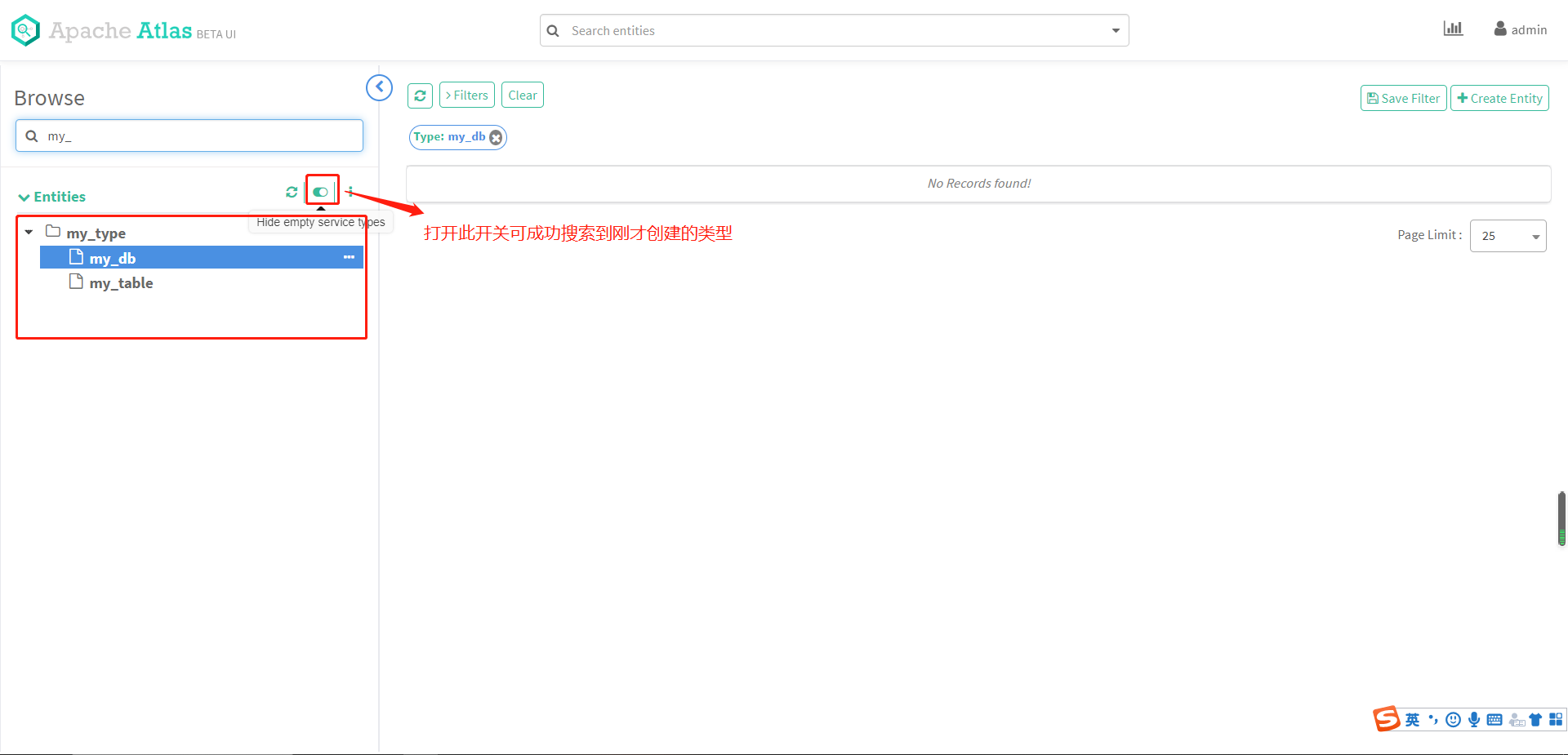
查看类型模型图:
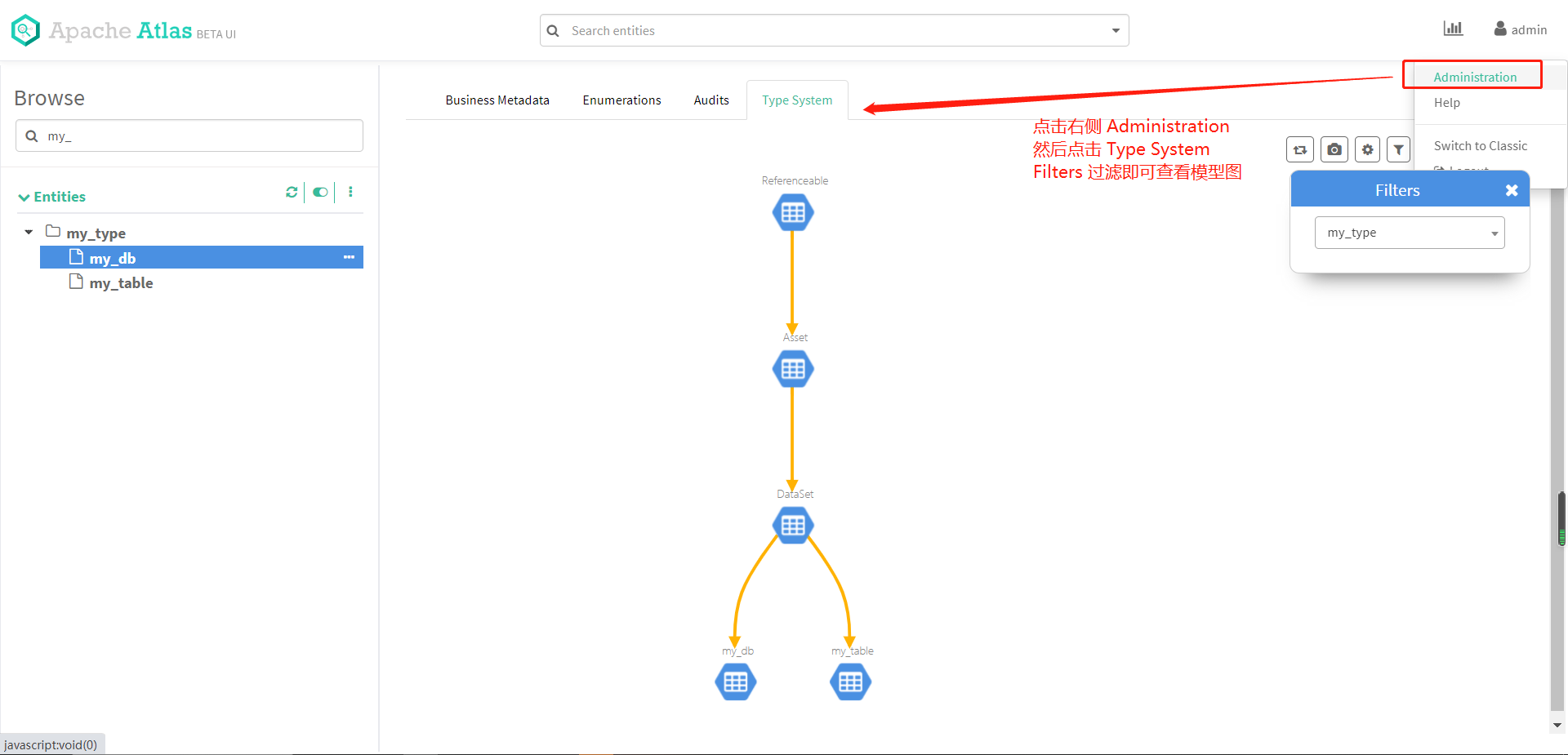
类型创建完毕,接下来我们进行实体的创建。
创建实体 test_db,test_table_source 和 test_table_target
json 如下:
//my_db 实体
{
"typeName": "my_db",
"attributes": {
"qualifiedName": "test_db",
"name": "test_db",
"description": "测试创建db"
}
}
//test_table_source 实体
{
"typeName": "my_table",
"attributes": {
"qualifiedName": "test_table_source",
"name": "test_table_source",
"description": "测试创建test_table_source"
},
"relationshipAttributes": {
"db": {
"typeName": "my_db",
//my_db的guid(创建完my_db后会返回)
"guid": "xxxx"
}
}
}
//test_table_target 实体
{
"typeName": "my_table",
"attributes": {
"qualifiedName": "test_table_target",
"name": "test_table_target",
"description": "测试创建test_table_target"
},
"relationshipAttributes": {
"db": {
"typeName": "my_db",
"guid": "xxx"
}
}
}
代码实现如下:
//创建实体 test_db
AtlasEntity testDb = new AtlasEntity();
testDb.setTypeName("my_db");
Map<String, Object> attributes = new HashMap<>();
attributes.put("qualifiedName", "test_db");
attributes.put("name", "test_db");
attributes.put("description", "测试创建db");
testDb.setAttributes(attributes);
Map<String, String> queryAttributes = new HashMap<>();
queryAttributes.put("qualifiedName", "test_db");
String myDbGuid = null;
try {
//查询不到会报错
AtlasEntity.AtlasEntityWithExtInfo extInfo = atlasClientV2.getEntityByAttribute("my_db", queryAttributes);
myDbGuid = extInfo.getEntity().getGuid();
} catch (AtlasServiceException e) {
if (ClientResponse.Status.NOT_FOUND.equals(e.getStatus())) {
AtlasEntity.AtlasEntityWithExtInfo extInfo = new AtlasEntity.AtlasEntityWithExtInfo(testDb);
//请求
EntityMutationResponse response = atlasClientV2.createEntity(extInfo);
myDbGuid = response.getGuidAssignments().values().toArray(new String[]{})[0];
}
}
//创建与db的关系
Map<String, Object> relationShipAttr = new HashMap<>();
Map<String, String> dbMap = new HashMap<>();
dbMap.put("guid", myDbGuid);
dbMap.put("typeName", "my_db");
relationShipAttr.put("db", dbMap);
//创建实体 test_table_source
AtlasEntity testTableSource = new AtlasEntity();
testTableSource.setTypeName("my_table");
attributes.put("qualifiedName", "test_table_source");
attributes.put("name", "test_table_source");
attributes.put("description", "测试创建test_table_source");
testTableSource.setAttributes(attributes);
testTableSource.setRelationshipAttributes(relationShipAttr);
queryAttributes.put("qualifiedName", "test_table_source");
try {
//atlasClientV2.updateEntity(new AtlasEntity.AtlasEntityWithExtInfo(testTableSource));
AtlasEntity.AtlasEntityWithExtInfo extInfo = atlasClientV2.getEntityByAttribute("my_table", queryAttributes);
testTableSource = extInfo.getEntity();
} catch (AtlasServiceException e) {
if (ClientResponse.Status.NOT_FOUND.equals(e.getStatus())) {
AtlasEntity.AtlasEntityWithExtInfo extInfo = new AtlasEntity.AtlasEntityWithExtInfo(testTableSource);
//请求
EntityMutationResponse response = atlasClientV2.createEntity(extInfo);
testTableSource.setGuid(response.getGuidAssignments().values().toArray(new String[]{})[0]);
}
}
//创建实体 test_table_target
AtlasEntity testTableTarget = new AtlasEntity();
testTableTarget.setTypeName("my_table");
attributes.put("qualifiedName", "test_table_target");
attributes.put("name", "test_table_target");
attributes.put("description", "测试创建test_table_target");
testTableTarget.setAttributes(attributes);
testTableTarget.setRelationshipAttributes(relationShipAttr);
queryAttributes.put("qualifiedName", "test_table_target");
try {
//atlasClientV2.updateEntity(new AtlasEntity.AtlasEntityWithExtInfo(testTableTarget));
AtlasEntity.AtlasEntityWithExtInfo extInfo = atlasClientV2.getEntityByAttribute("my_table", queryAttributes);
testTableTarget = extInfo.getEntity();
} catch (AtlasServiceException e) {
if (ClientResponse.Status.NOT_FOUND.equals(e.getStatus())) {
AtlasEntity.AtlasEntityWithExtInfo extInfo = new AtlasEntity.AtlasEntityWithExtInfo(testTableTarget);
//请求
EntityMutationResponse response = atlasClientV2.createEntity(extInfo);
testTableTarget.setGuid(response.getGuidAssignments().values().toArray(new String[]{})[0]);
}
}
执行代码完毕后,查看类的树形图,发现已经产生了实体:
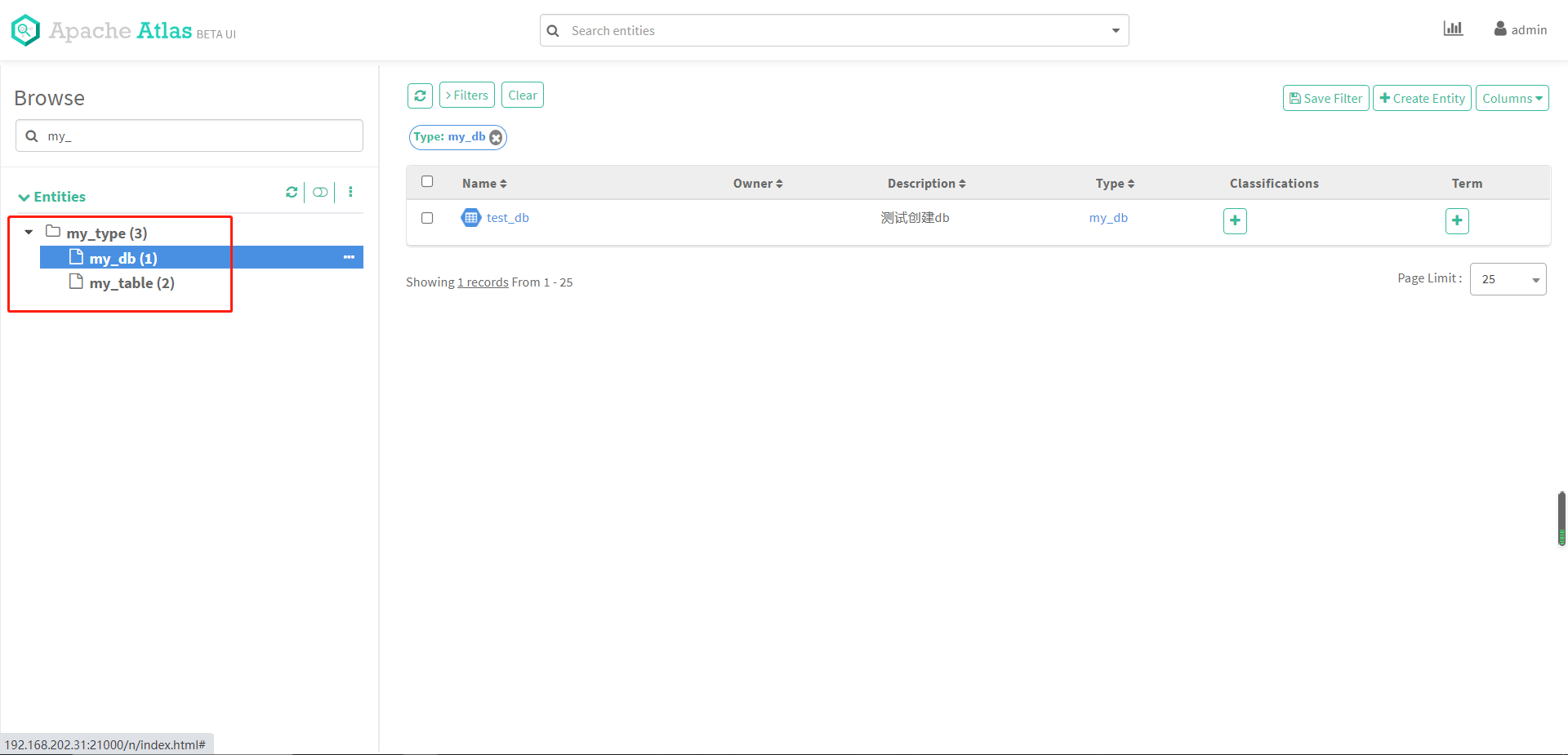
我们点击右侧的 test_db 实体,可以看到它的基本信息,也可以看到它的 relationship 信息,包含了 test_table_source 和 test_table_target 两个实体:
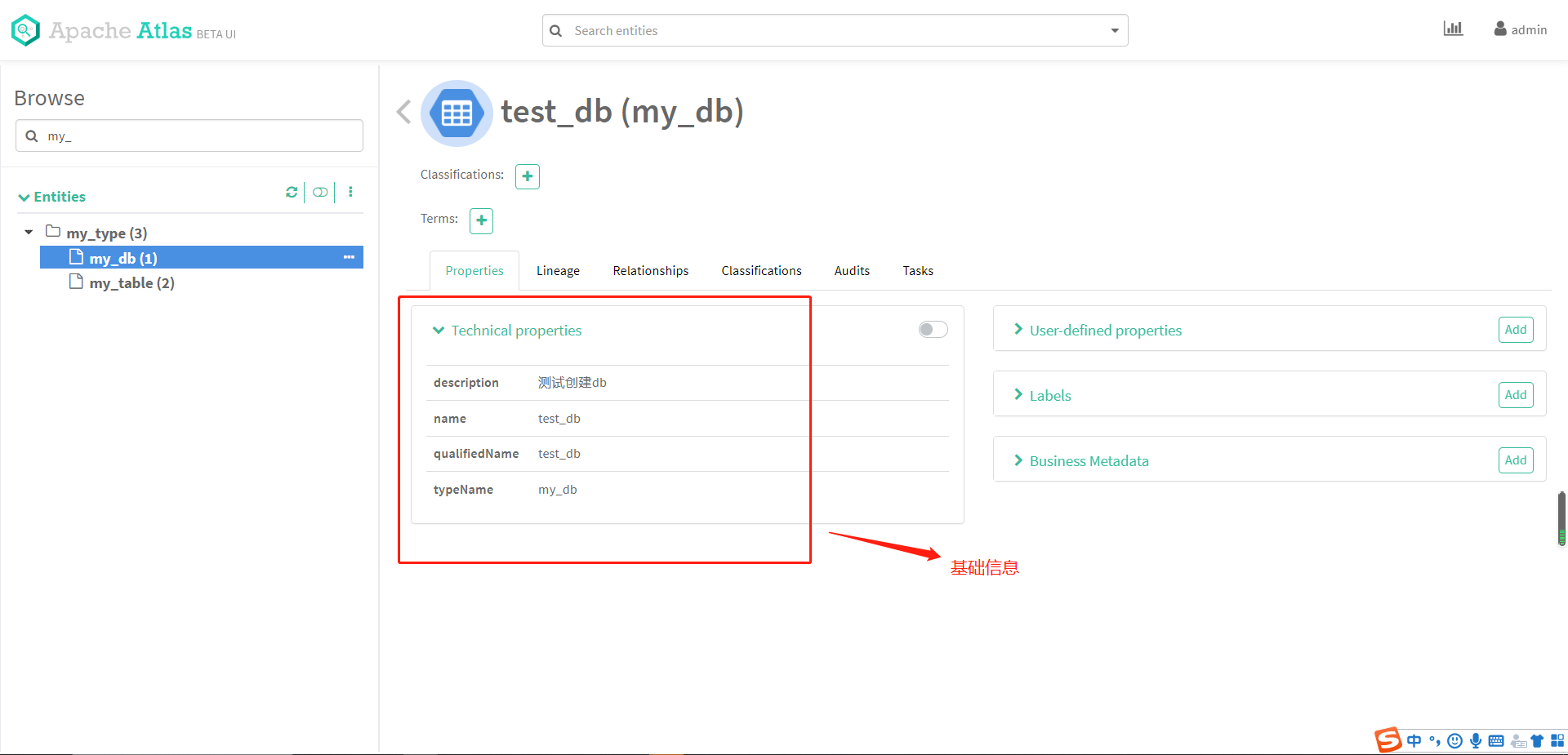
查看 relationship 信息,包含 test_table_source 和 test_table_target:
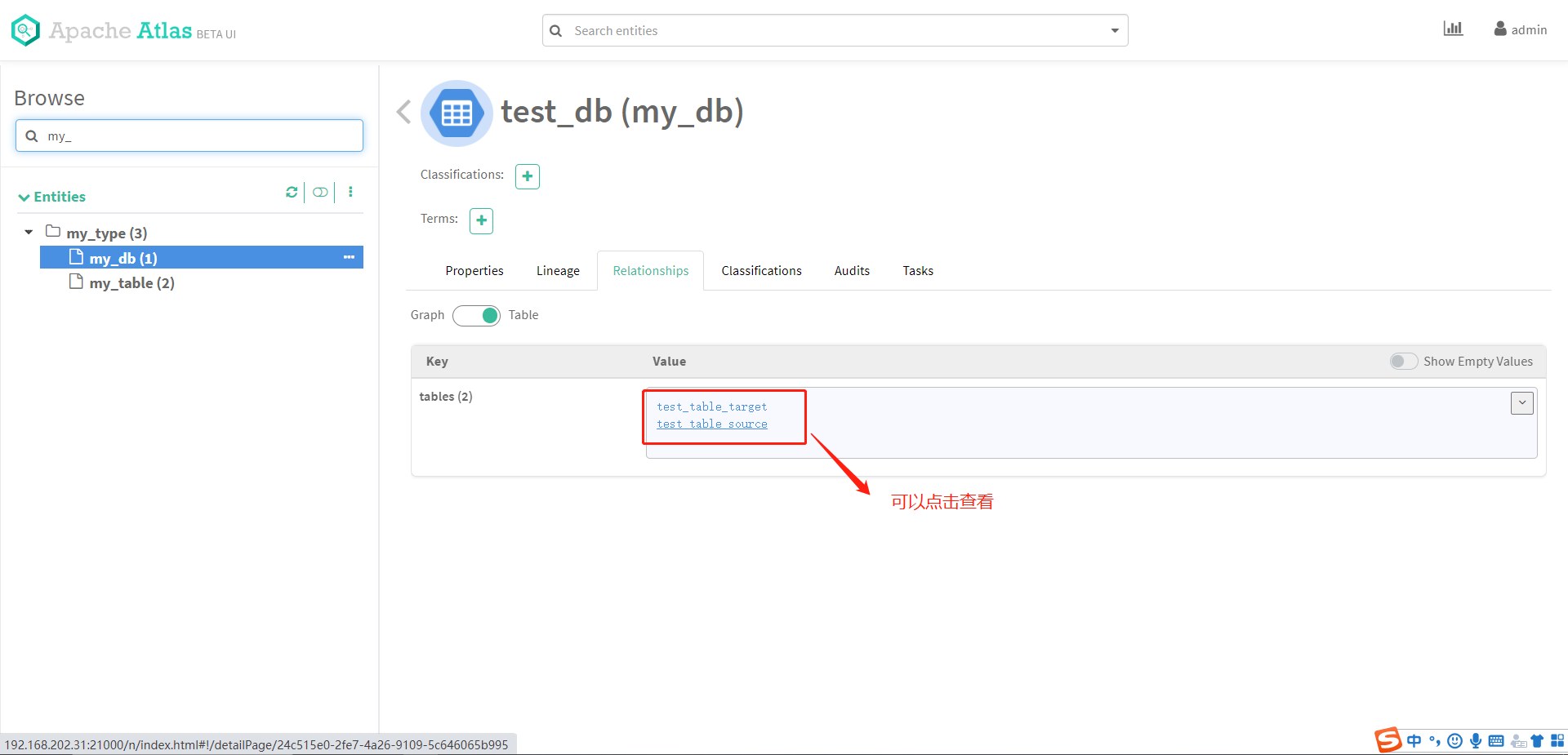
创建 test_table_source 和 test_table_target 的血缘关系依赖
前面我们提到,定义 test_table_target 的数据来自 test_table_source,血缘关系依赖在 Atlas 中其实也是作为实体 Entity 存在,只不过继承的父类是 Process,这样可以定义 inputs 和 outputs 属性,构建血缘关系,json 如下:
{
"typeName": "Process",
"attributes": {
"name": "test_process",
"qualifiedName": "test_process",
"description": "test_table_target 的数据来自 test_table_source",
"inputs": [{
"typeName": "my_table",
//test_table_source的guid,创建实体从返回的信息中获取
"guid": "xxx"
}],
"outputs": [{
"typeName": "my_table",
////test_table_target的guid,创建实体从返回的信息中获取
"guid": "xxx"
}]
}
}
代码实现如下:
AtlasEntity lineage = new AtlasEntity();
//设置为process类型构建血缘
lineage.setTypeName(AtlasBaseTypeDef.ATLAS_TYPE_PROCESS);
attributes.put("qualifiedName", "test_process");
attributes.put("name", "test_process");
attributes.put("description", "test_table_target 的数据来自 test_table_source");
attributes.put("inputs", getLineAgeInfo(testTableSource));
attributes.put("outputs", getLineAgeInfo(testTableTarget));
lineage.setAttributes(attributes);
queryAttributes.put("qualifiedName", "test_process");
System.out.println(SingletonObject.OBJECT_MAPPER.writeValueAsString(lineage));
try {
//查询是否存在
atlasClientV2.getEntityByAttribute(AtlasBaseTypeDef.ATLAS_TYPE_PROCESS, queryAttributes);
} catch (AtlasServiceException e) {
if (ClientResponse.Status.NOT_FOUND.equals(e.getStatus())) {
//创建
AtlasEntity.AtlasEntityWithExtInfo extInfo = new AtlasEntity.AtlasEntityWithExtInfo(lineage);
atlasClientV2.createEntity(extInfo);
}
}
//构建inputs和outputs
private static List<Map<String, String>> getLineAgeInfo(AtlasEntity entity) {
List<Map<String, String>> list = new ArrayList<>();
Map<String, String> map = new HashMap<>();
map.put("guid", entity.getGuid());
map.put("typeName", entity.getTypeName());
list.add(map);
return list;
}
执行以上代码,然后打开主页,点击 my_table 中的 test_table_source,查看 lineage 标签,血缘关系已成功构建:
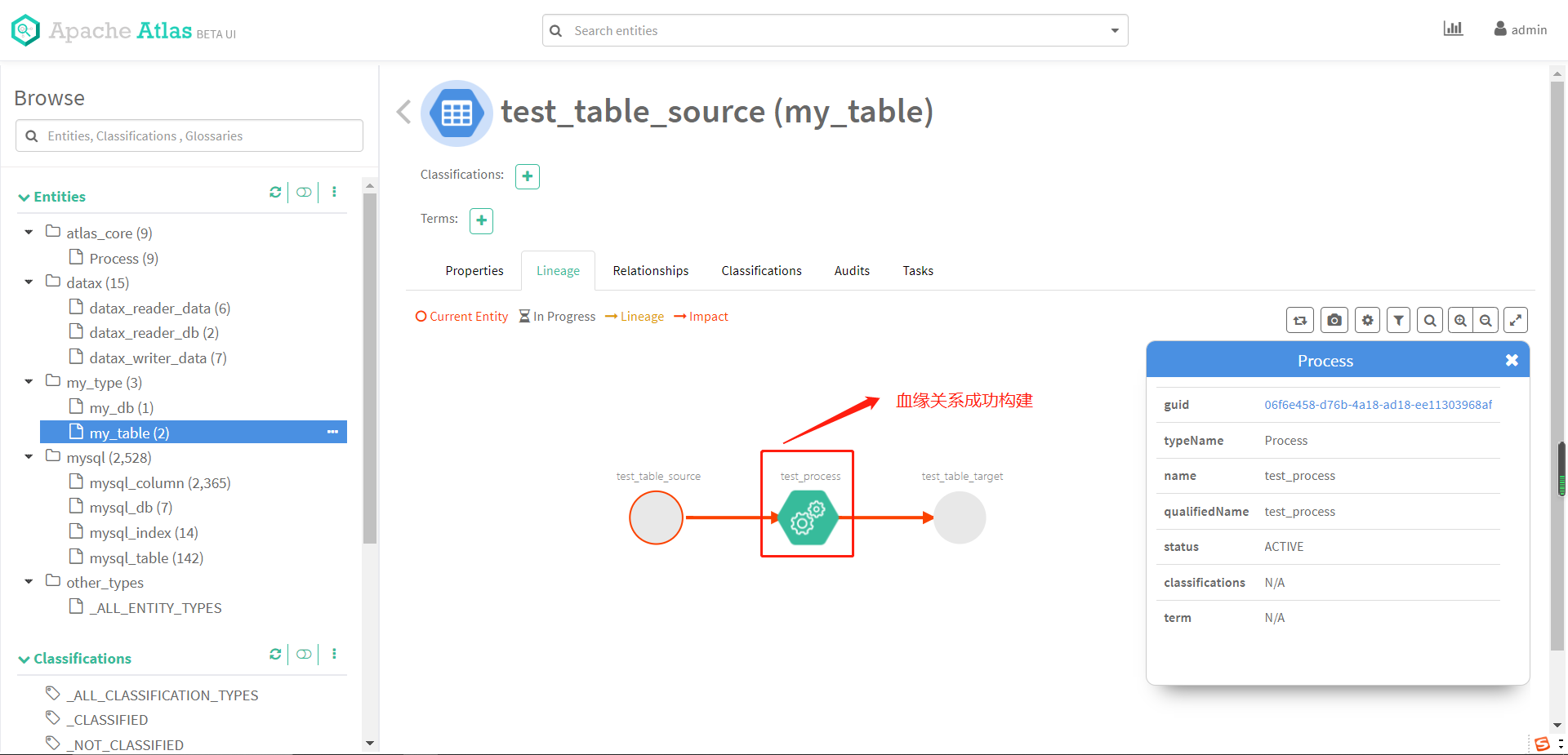
至此,我们通过 Atlas Rest Api 的方式自行建模,创建实体,构建血缘关系就完成了。
结语
通过此文,我们可以由浅入深,理解 Atlas 的概念和原理,同时也可以掌握 Atlas 的 Rest Api,日后如果有二次开发的需求,可以为此奠定良好的基础,我所在的公司就是基于 Atlas 搭建了自己的数据中台,UI 界面也都是自己重新实现的,比原生的界面好看很多,并且实现了自己的许多个性化需求。
网上 Atlas 的教程相对较少,特别是 Rest Api 这块很是缺乏,所以特地写了这篇文章。元数据管理,数据治理,在当下仍然是一个热门的话题,同时,它也可以帮助我们更好的支撑企业的数据资产,更好的分析数据,为企业的发展决策提供有效的帮助。
希望本文能对你有所感悟,有所启发,我们下次更新,再见!
关注公众号螺旋编程极客 获取最新干货推送,感兴趣的朋友也可以在公众号下方菜单进群交流,期待你的关注!
